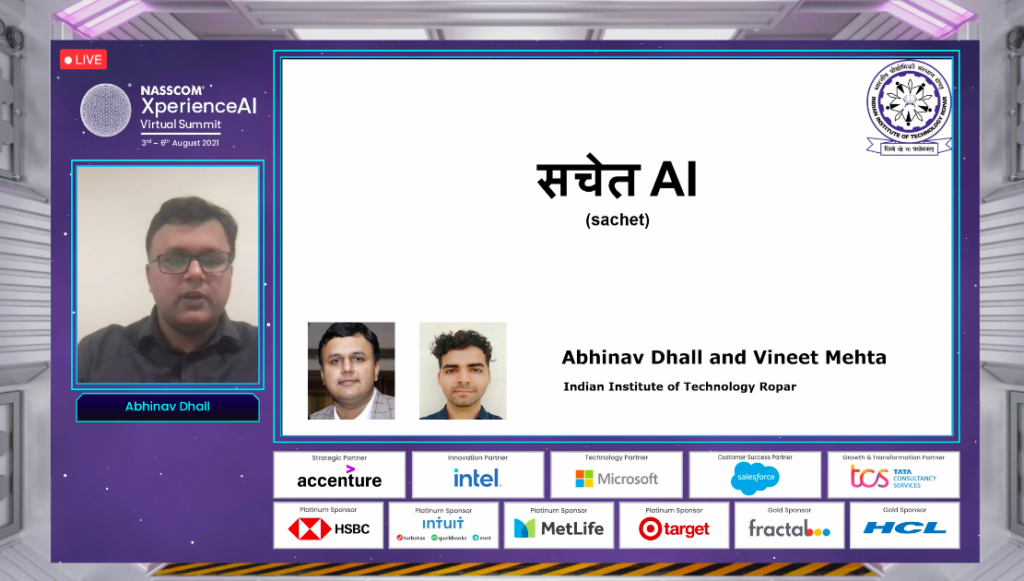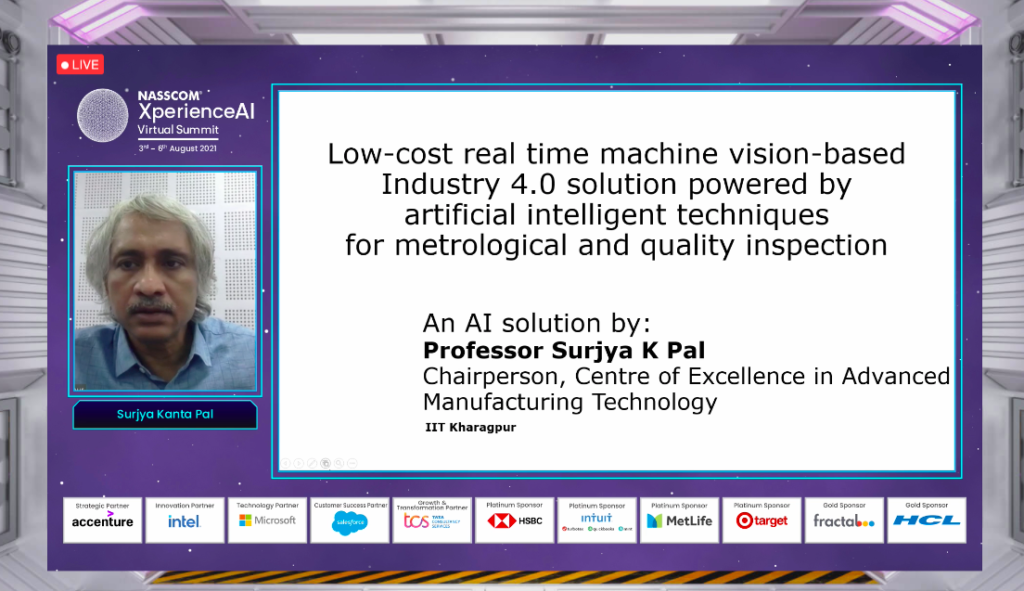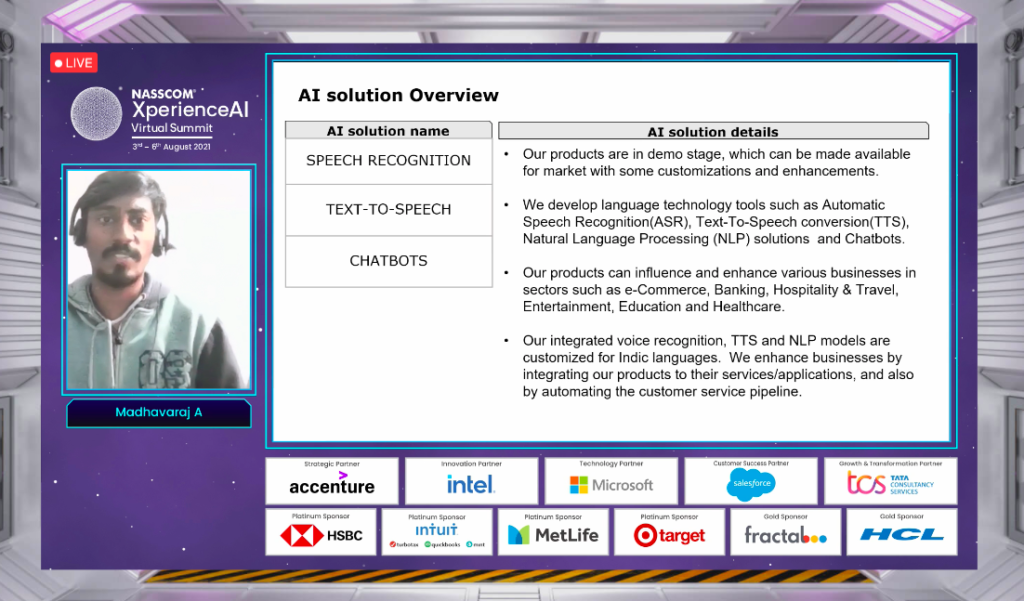The highly anticipated search for the most innovative Lab2Market solutions culminated on the inaugural day of the 4-day Xperience AI Virtual Summit. From several applications, three solutions were shortlisted to be showcased at the one-hour virtual session to panel members Kapil Bardeja, Co-Founder, Vehant Technologies; Kritika Murugesan, Director, 10,000 Start-ups, NASSCOM; Mitesh Shah, Co-Founder, Inflection Point Ventures and Dr. Sunil Kumar Vuppala, Director – Data Sciences, Ericsson.
Here are the top three solutions:
Sachet AI : Dr Abhinav Dhall & Vineet Mehta, IIT Ropar

Sachet AI (means conscious in Hindi) is an AI-based SaaS and on-device distraction and intoxication detection engine. Even though driving is among the safest activities that humans can engage in, distractions and intoxication can greatly hamper a driver’s ability to navigate a vehicle safely. Drunk driving in India has caused over 38,000 road accidents over the last three years (between 2016 and 2019). In the USA, drunk driving causes more than 10,000 deaths every year, accounting for 1/3 of traffic-related deaths. Drinking and driving costs more than $44 billion in deaths and damages annually.
Using computer vision, deep learning and effective computing, Sachet AI allows for distraction and intoxication detection with 88% accuracy. In comparison to conventional methods to check erratic driving, Sachet AI is non-invasive, data-driven, low-cost and safer to use. The IIT Ropar team working on Sachet AI utilized nearly 10,000 data points of Caucasian face, but plans to get local datasets and eventually retrain algorithms, for which user inputs are essential. The solution solely focuses on audio-visual analysis to determine distraction or intoxication levels.
Dr. Dhall, in his presentation, attested to challenges in data collection and computational abilities while building this solution. Currently, the solution is at a Proof-of-Concept stage and is applicable to a B2B (ride sharing), B2C (workplace safety) and B2B2C (health & wellness) setup.
Low-Cost, Real-Time Machine Vision Based Industry 4.0 Solution, Powered by AI Techniques for Metrological and Quality Inspection: Professor Surjya K Pal, IIT Kharagpur

Dr. Pal presented a challenge that is more common in large industry settings than one might imagine. In several MSMEs, manual inspection of mundane tasks still takes place which can either lead to largescale rejection of quality goods or inversely, approval of faulty pieces. The human eye progressively loses accuracy and ability to discern anomalies, as tasks get repetitive and fatigue sets in.
The solution built by Dr Pal and his team is a low-cost, real-time machine vision-based Industry 4.0 solution, powered by AI techniques for metrological and quality inspection. For this, Dr Pal has developed their own algorithm OPGAN (optimized probabilistic generative adversarial neural network). A low-cost webcam and Python-based OpenCV platform are deployed for real-time image capture, followed by OPGAN for real-time image enhancement with 99% accuracy, feature extraction for dimensional measurement and quality for real-time image processing and GUI for information display that can help deliver futuristic insights for statistical analysis and data storing.
This solution can be deployed in industries that rely on quality inspection, automobile part manufacturers, smartphone manufacturers and glass makers. Dr Pal added that the solution is TRL 5-ready and is supported by multiple experiments for testing. Moreover, the solution doesn’t depend on prior datasets to deliver highly accurate results.
Speech Recognition, Text to Speech and Chatbots: Madhavaraj A, Indian Institute of Science (IISc) Bangalore

Last month, Bangalore-based Voice-as-a-Service startup Slang Labs raised capital from Google Assistant Investments along with other marquee investors – and this solidified the industry sentiment towards voice AI. Companies like Slang Labs are democratizing a readily available resource and rich data point – voice.
In a similar vein, Madhavaraj S from IISc has developed a series of language technology tools such as Automatic Speech Recognition (ASR), Text to Speech Conversion (TTS), Natural Language Processing and Chatbots, customized for Indic languages. At the heart of the voice-first interface is an inhouse, advanced neural network architecture trained with high quality speech data.
The product suite developed by Madhavaraj can influence businesses across sectors like banking, hospitality, travel, entertainment, education and healthcare. The framework for building entity recognition, intent recognition and intent process flow using state machines and advanced neural networks enables the team to build customized chatbots based on specific requirements of these businesses.
Recognising that high quality data in Indic languages is the biggest challenge in the domain of voice AI for India, Madhavaraj and his team have prepared a data collection pipeline that collects data customized for use in speech applications. They started with Tamil, and have utilized the same pipeline for Hindi, Kannada and Indian English for the initial training of the models. The team has filed patents for the specific challenges seen in Indian languages like agglutination and inflection.
Source: indiaai.gov.in








